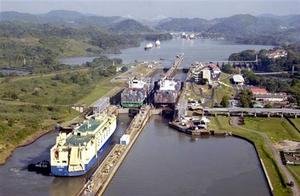China syndromeChina plans to build alternative to Panama Canal
China recently struck a deal with Colombia to build a railway system that would connect the Atlantic to the Pacific oceans; China hopes this link will create a viable alternative to the Panama Canal; the railway would help ease China’s growing demand for raw materials, particularly coal, and act as an additional outlet for Chinese exports; Colombia is the fifth largest coal producer in the world, but most of its coal is exported through its ports on the Atlantic side; trade between China and Colombia has skyrocketed from $10 million in 1980 to $5 billion in 2010

Chinese seek to replace the Panama canal // Source: nyteknik.se
In an ambitious plan, China recently struck a deal with Colombia to build a railway system that would connect the Atlantic to the Pacific oceans. China hopes this link will create a viable alternative to the Panama Canal.
Currently the primary alternative for transporting goods from the Atlantic Ocean to the Pacific Ocean has been the rail way system in the United States that connects its western coast to the eastern seaboard. While faster, it is more expensive. The Guardian reports that both the Chinese and Colombian governments have confirmed plans to build a 280-mile long railway network connecting the country’s Pacific coast to Cartagena in the Caribbean Sea.
The railway would help ease China’s growing demand for raw materials, particularly coal, and act as an additional outlet for Chinese exports.
In an interview with the Financial Times, Colombian president Juan Manuel Santos, said, “It’s a real proposal … and it is quite advanced.”
He added, “The studies [the Chinese] have made on the costs of transporting per ton, the cost of investment, they all work out.”
President Santos hopes “to create a whole city south of Cartagena in the Caribbean, as a hub for production and assembly to export to the rest of South America and Central America and even to the United States. There’s a proposal to build whole railway system that would even connect Venezuela with the Pacific.”
The creation of an alternative link between the Pacific and Atlantic oceans has been attempted multiple times in recent history in addition to attempts dating as far back as 1534 by Spanish explorers. These efforts were stymied by lack of funding, poor planning, disease, and other logistical difficulties.
Acknowledging past attempts, President Santos said,” It’s not a new idea. I remember some years ago one of the most prestigious advisors for the World Bank was obsessed by this idea. And president [Virgilio] Barco flirted with the idea a lot.”
President Santos remains optimistic that with Chinese funding the project will be financially viable.
China has been actively bolstering ties with South American countries. In the past two years, China has lent more money to developing countries than the World Bank.
Trade between China and Colombia has skyrocketed from $10 million in 1980 to $5 billion in 2010, making it China’s second largest trading partner behind the United States.
China is also building the world’s largest industrial port in Brazil to facilitate the transport of millions of tons of iron ore, grain, soy, and oil to help ease its ever-growing demand for energy and natural resources.
The proposed rail link in Columbia would begin in the Pacific to a new city near Cartagena where imported Chinese goods would be assembled for export throughout North and South America, while raw materials from Colombia would flow back to China.
Colombia is the fifth largest coal producer in the world, but most of its coal is exported through its ports on the Atlantic side.
According to Heather Berkman, an analyst with the Eurasia Group, the rail link would help ease transportation bottlenecks in Colombia’s mining industry.
Chinese and Colombian officials are currently most interested in completing talks over the construction of a nearly 500-mile long rail road and the expansion of its Buenaventura port on the Pacific coast. This $7.6 billion project would transport as much as forty million tons of cargo each year from Colombia’s industrial centers to the Pacific, with priority given to coal headed for China.
